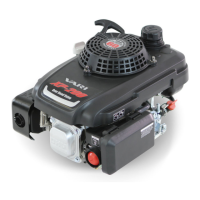VARI XP-200
3.4 Specifications of the engine
Description Unit Value
Engine type - XP200 (1P70F/P-H)
Bore x Stroke mm 70 x 51
Displacement cm
3
196
Zapalovací systém - Tranzistor magneto
Ignition system - Recoil starter
Maximum Outout power/Speed kW/min
-1
3,6/3800
Maximum Torque/Speed Nm/min
-1
10/3000
Idle speed min
-1
1520±152
Valve lash Intake
Exhaust
mm 0,10-0,15
0,15-0,20
Specific fuel consumption g/kW.h ≤ 395
Lube consupmtion g/kW.h ≤ 6,8
Noise
Standart
Sound pressure level dB(A)
Sound power level dB(A)
The Noise level was tested according to
EN 1679-1, EN ISO 3744
76
97
Net weight kg 14
Dimensions (L x W x H) – excluding the crankshaft
output
mm
415x340x270
Tab. 2: Engine specification
4 Operation
4.1 Before operation
Is your engine ready to go?
For your safety, and to maximize the service life of your equipment, it is very important to take a few moments before you operate the
engine to check its condition, be sure to take care of any problem you find, or have your serving dealer correct it, before you operate the
engine.
Improperly maintaining this engine, or failing to correct a problem before operation, could cause a malfunction in which you could be
seriously injured.
Always perform a preoperation inspection before each operation, and correct any problem.
Before beginning your preoperation checks, be sure the engine is level and the engine switch is in the OFF position.
4.1.1 Check the general condition of the engine
• Look around and underneath the engine for signs of oil or gasoline leaks.
• Remove any excessive dirt or debris, especially around the muffler and recoil starter
• Look for signs of damage..
• Check that all shields and covers are in place, and all nuts, bolts,
• and screws are tightened.
4.1.2 Check the engine
• Check the engine oil level, running the engine with a low oil level can cause engine damage.
• Check the air filter, A dirty air filter will restrict air flow to the carburetor, reducing engine performance.
• Check the fuel level, starting with a full tank will help to eliminate or reduce operating interruptions for refueling.
8
Revision 12/2013

